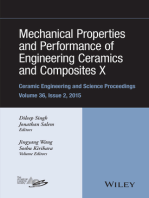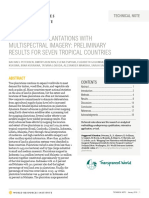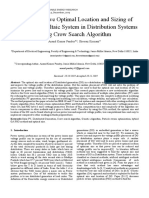0 ratings0% found this document useful (0 votes)
123 viewsC55E
C55E
Uploaded by
niranjanbmazireThis document provides information on the chemical composition, mechanical properties, heat treatment processes, and standards for steel grade C55E. Some key points include:
- The chemical composition of C55E steel includes a carbon content between 0.52-0.60% and controlled amounts of other elements like silicon, manganese, phosphorus, and sulfur.
- Heat treatments include normalizing, quenching, tempering, and stress relieving within specified temperature ranges to achieve desired mechanical properties.
- Testing data shows the steel achieves a tensile strength between 640-1050 MPa and yield strength between 300-550 MPa depending on size, condition, and specification.
- The
Copyright:
© All Rights Reserved
Available Formats
Download as PDF, TXT or read online from Scribd
C55E
C55E
Uploaded by
niranjanbmazire0 ratings0% found this document useful (0 votes)
123 views2 pagesThis document provides information on the chemical composition, mechanical properties, heat treatment processes, and standards for steel grade C55E. Some key points include:
- The chemical composition of C55E steel includes a carbon content between 0.52-0.60% and controlled amounts of other elements like silicon, manganese, phosphorus, and sulfur.
- Heat treatments include normalizing, quenching, tempering, and stress relieving within specified temperature ranges to achieve desired mechanical properties.
- Testing data shows the steel achieves a tensile strength between 640-1050 MPa and yield strength between 300-550 MPa depending on size, condition, and specification.
- The
Original Description:
C55 material sheet
Copyright
© © All Rights Reserved
Available Formats
PDF, TXT or read online from Scribd
Share this document
Did you find this document useful?
Is this content inappropriate?
This document provides information on the chemical composition, mechanical properties, heat treatment processes, and standards for steel grade C55E. Some key points include:
- The chemical composition of C55E steel includes a carbon content between 0.52-0.60% and controlled amounts of other elements like silicon, manganese, phosphorus, and sulfur.
- Heat treatments include normalizing, quenching, tempering, and stress relieving within specified temperature ranges to achieve desired mechanical properties.
- Testing data shows the steel achieves a tensile strength between 640-1050 MPa and yield strength between 300-550 MPa depending on size, condition, and specification.
- The
Copyright:
© All Rights Reserved
Available Formats
Download as PDF, TXT or read online from Scribd
Download as pdf or txt
0 ratings0% found this document useful (0 votes)
123 views2 pagesC55E
C55E
Uploaded by
niranjanbmazireThis document provides information on the chemical composition, mechanical properties, heat treatment processes, and standards for steel grade C55E. Some key points include:
- The chemical composition of C55E steel includes a carbon content between 0.52-0.60% and controlled amounts of other elements like silicon, manganese, phosphorus, and sulfur.
- Heat treatments include normalizing, quenching, tempering, and stress relieving within specified temperature ranges to achieve desired mechanical properties.
- Testing data shows the steel achieves a tensile strength between 640-1050 MPa and yield strength between 300-550 MPa depending on size, condition, and specification.
- The
Copyright:
© All Rights Reserved
Available Formats
Download as PDF, TXT or read online from Scribd
Download as pdf or txt
You are on page 1of 2
Quality C55E
According to standards EN 10083-2: 2006
Lucefin Group
Number 1.1203
Chemical composition
C% Si%
max
Mn% P%
max
S%
max
Cr%
max
Mo%
max
Ni%
max
0,52-0,60 0,40 0,60-0,90 0,030 0,035 0,40 0,10 0,40
0.03 +0.03 0.04 + 0.005 + 0.005 -- -- --
Permissible deviations
on the product
Cr+Mo+Ni max 0.63%
C55R n 1.1209 S% 0.020-0.040 permissible deviations + 0.005
C55 n 1.0535 P% - S% max 0.045
Temperature C
Hot forming Normalizing Quenching Quenching Tempering Stress relieving
1050-850 825-885
air
830
water
850
oil or polymer
550-650
air
50 under the
temperature of tempering
Soft
annealing
Isothermal
annealing
Natural End quench
hardenability test
Preheating
welding
Stress relieving
after welding
250 600 furnace cooling
AC1 AC3 MS Mf
680-700
air
(HB max 229)
790 furnace cooling
to 660 after, air
--
(HB max 255)
830
water
730 765 300 80
Mechanical and physical properties
Hot formed hot rolled - rod mechan. properties for normalized condition EN 10083-2: 2006
Testing at room temperature (longitudinal) size d / t
mm R Re
a)
A% C% Kv HB
over to N/mm
2
min N/mm
2
min. min. min. J min. min
16/16 680 370 11 -- -- 208
16/16 100/100 640 330 12 -- -- 198
100/100 250/250 620 300 12 -- -- 190
d = diameter t = thickness
Hot formed hot rolled mechan. properties for quenched and tempered condition EN 10083-2: 2006
Testing at room temperature (longitudinal) size d / t
mm
R Re
a)
A% C% Kv HB
over to N/mm
2
N/mm
2
min min. min. J min for information
16/8 800-950 550 12 30 -- 240-286
16/8 40/20 750-900 490 14 35 -- 225-271
40/20 100/60 700-850 420 15 40 -- 213-253
a)
Re upper yield strength or, if no yield phenomenon occurs, the 0.2% proof strength Rp 0.2
d = diameter t = thickness
Table of tempering values at room temperature for round 60 mm after quenching at 830 C in oil
HB 286 268 253 240 226 223 162
HRC 28 25 23 22.5 20 -- --
R N/mm
2
950 890 850 800 760 720 560
Rp 0.2 N/mm
2
650 590 530 480 430 400 380
A % 9 11 13 16 18 19 24
C % 28 38 42 45 50 50 --
Tempering at C 400 450 500 550 600 650 690 (annealing)
C55 1.0535 EN 10277-2: 2008 Lucefin Group
Cold drawn +C
c)
Hot rolled + Peeled Reeled +SH
c)
Testing at room temperature (longitudinal) Testing at room temperature (longitudinal) size
mm R
a)
Rp 0.2
a)
A% HB R Rp 0.2 A% HB
over to N/mm
2
N/mm
2
min min for inform. N/mm
2
N/mm
2
min min
5
b)
10 770-1100 590 5 231-331 -- -- -- --
10 16 730-1080 520 6 224-327 -- -- -- --
16 40 690-1050 440 7 210-319 610-910 -- -- 181-269
40 63 650-1030 390 8 200-311 610-910 -- -- 181-269
63 100 -- -- -- -- 610-910 -- -- 181-269
a)
for flats and special sections yield point can be 10% and tensile strenght can be 10%
b)
for thickness below 5 mm mechanical properties can be agreed before order placement
c)
values valid also for +C+SL and +SH+SL
C55E 1.1203 Forged normalized EN 10250-2: 2001
Testing at room temperature (longitudinal) size
mm R Re
c)
A% L A% T A% Q Kv L Kv T HB
over to N/mm
2
min N/mm
2
min min min min J min J min min
100 640 330 12 -- -- -- -- 198
100 250 620 300 12 9 -- -- -- 190
250 500 600 260 12 9 -- -- -- 178
500 1000 590 250 11 8 -- -- -- 176
d = diameter t = thickness
C55E 1.1203 Forged quenched and tempered EN 10250-2: 2001
Testing at room temperature (longitudinal) size d / t
mm R Re
c)
A% L A% T C% L Kv L Kv T HB
over to N/mm
2
min N/mm
2
min min min J min J min J min min
100/70 700 420 15 -- -- -- -- 213
100/70 250/160 630 360 17 11 -- -- -- 192
250/160 500/330 610 330 16 10 -- -- -- 183
L = longitudinal T = tangential Q = radial
c)
Re upper yield strength or, if no yield phenomenon occurs, the 0.2% proof strength Rp 0.2
d = diameter t = thickness
EN 10083-2: 2006 Jominy test HRC grain size 5 min.
distance in mm from quenched end
1 2 3 4 5 6 7 8 9 10 11 13 15 20 25 30
min 58 55 47 37 33 32 31 30 29 28 27 26 25 24 22 20
max 65 64 63 62 60 57 52 45 37 36 35 34 33 32 30 29
H
normal
Temperature Mod. of elasticity N/mm
2
Rp 0.2 N/mm
2
Thermal expansion Density
Testing at C E long. G tang.
< 250 mm 250-500
[(m/mK)
10-6
C
-1
] Kg/dm
3
20 205000 78700 -- -- -- 7.85
EUROPE EN ITALY UNI CHINA GERMANY DIN FRANCE AFNOR U.K. B.S. RUSSIA USA AISI/SAE
C55E C55 55 Ck55 XC55 H1 870M55 -- 1055
You might also like
- Wire Rope LubricationDocument16 pagesWire Rope LubricationAnonymous alQXB11EgQNo ratings yet
- Technical Card Ck45 Mechanical PropertiesDocument3 pagesTechnical Card Ck45 Mechanical PropertiesNuno Miguel TorcatoNo ratings yet
- 1 8159-51CrV4Document2 pages1 8159-51CrV4black_absynthNo ratings yet
- E295 PDFDocument1 pageE295 PDFNunoAfonsoNo ratings yet
- En10083-2 - 1996 - C35eDocument3 pagesEn10083-2 - 1996 - C35ealextentwentyNo ratings yet
- Quality E335Document1 pageQuality E335Sivanaga DantuluriNo ratings yet
- Ck45 Mechanical PropertiesDocument3 pagesCk45 Mechanical PropertiesDaniel CringusNo ratings yet
- Quality 42crmo4 Chemical Composition: Technical Card Gruppo Lucefin Revision 2012 All Rights ReservedDocument2 pagesQuality 42crmo4 Chemical Composition: Technical Card Gruppo Lucefin Revision 2012 All Rights ReservedVijayakumar SamyNo ratings yet
- 34 CR Mo 4Document2 pages34 CR Mo 4Stefan GhNo ratings yet
- AISI416Document2 pagesAISI416shamsi862620No ratings yet
- C45EDocument3 pagesC45ETrương Định100% (1)
- S235JR Sau OL 37Document1 pageS235JR Sau OL 37Pișta GonzalesNo ratings yet
- AISI304Document2 pagesAISI304tony_abNo ratings yet
- 36NiCrMo16 PDFDocument2 pages36NiCrMo16 PDFAmy GriffinNo ratings yet
- 41Cr4 Chemical PDFDocument2 pages41Cr4 Chemical PDFGayathriRajasekaranNo ratings yet
- 102 CR 6Document2 pages102 CR 6ceca nikolicNo ratings yet
- 34 CR Mo 4Document2 pages34 CR Mo 4ceca nikolicNo ratings yet
- 34 CR Ni Mo 6Document2 pages34 CR Ni Mo 6hp_vijayk0% (1)
- 1.0577 S355J2Document1 page1.0577 S355J2sergonNo ratings yet
- 39 Ni CR Mo 3Document2 pages39 Ni CR Mo 3Lokesh Krishnappa100% (2)
- 40NiCrMo7 PDFDocument2 pages40NiCrMo7 PDFAmy Griffin0% (1)
- CR Mo 4Document2 pagesCR Mo 4Mohsen ParpinchiNo ratings yet
- Tempering Conditions For 30CrNiMo8Document2 pagesTempering Conditions For 30CrNiMo8madyeNo ratings yet
- 1 4571a316ti69Document2 pages1 4571a316ti69Admir TalicNo ratings yet
- Quality 102Cr6: Lucefin GroupDocument1 pageQuality 102Cr6: Lucefin GroupPaulo ZechinNo ratings yet
- Material 1.2312 - 40CrMnMoS8-6Document1 pageMaterial 1.2312 - 40CrMnMoS8-6johnnydoe90No ratings yet
- Quality 1.4021 Chemical Composition: Lucefin GroupDocument2 pagesQuality 1.4021 Chemical Composition: Lucefin GroupSonNguyenNo ratings yet
- Quality 42crmo4: Lucefin GroupDocument1 pageQuality 42crmo4: Lucefin GroupAnonymous Gbers2ENo ratings yet
- XC 38 H 1Document1 pageXC 38 H 1smith willNo ratings yet
- 1 8550-34CrAlNi710Document2 pages1 8550-34CrAlNi710Michel PortalNo ratings yet
- Material 1.2738 - 40CrMnNiMo8-6-4Document1 pageMaterial 1.2738 - 40CrMnNiMo8-6-4johnnydoe90100% (1)
- 30 CR Ni Mo 8Document2 pages30 CR Ni Mo 8Amy GriffinNo ratings yet
- 41 CR 4Document2 pages41 CR 4Jhon ChitNo ratings yet
- RG RM RGH DatasheetDocument3 pagesRG RM RGH DatasheetMomogi ForeverhappyNo ratings yet
- RG RM RGH Datasheet PDFDocument3 pagesRG RM RGH Datasheet PDFNNMSANo ratings yet
- 28mm Size Ring Type: A Low-Profile Unit With 4mm Height and Good Operation FeelDocument3 pages28mm Size Ring Type: A Low-Profile Unit With 4mm Height and Good Operation FeelshyhuNo ratings yet
- 100Cr6 PropertiesDocument1 page100Cr6 PropertiesRudrendu ShekharNo ratings yet
- Quality SAE 1018: Lucefin GroupDocument1 pageQuality SAE 1018: Lucefin GrouponeakshayNo ratings yet
- Quality: Astm A 105Document1 pageQuality: Astm A 105Venkat NarasimmanNo ratings yet
- 35mm Size Ring Type: A Low-Profile Unit With 4.5mm Height and Good Operation FeelDocument3 pages35mm Size Ring Type: A Low-Profile Unit With 4.5mm Height and Good Operation FeelshyhuNo ratings yet
- 1 2714Document1 page1 2714K Mohana PraneshNo ratings yet
- Dunaferr - Cold - RolledDocument12 pagesDunaferr - Cold - RolledMihály PálffyNo ratings yet
- Quality X20Cr13: Lucefin GroupDocument2 pagesQuality X20Cr13: Lucefin GroupRajeev ChandelNo ratings yet
- 21mm Size Ring Type: Ring Encoder With 4mm Height Contribute To Space Saving and MultifunctioningDocument4 pages21mm Size Ring Type: Ring Encoder With 4mm Height Contribute To Space Saving and MultifunctioningshyhuNo ratings yet
- Material 1.2379 - X153CrMoV12Document2 pagesMaterial 1.2379 - X153CrMoV12johnnydoe90No ratings yet
- 18 Ni CR Mo 5Document2 pages18 Ni CR Mo 5lavius_mNo ratings yet
- Quality C10E: Lucefin GroupDocument3 pagesQuality C10E: Lucefin Grouptuananh638No ratings yet
- Ceramic Materials for Energy Applications V: A Collection of Papers Presented at the 39th International Conference on Advanced Ceramics and CompositesFrom EverandCeramic Materials for Energy Applications V: A Collection of Papers Presented at the 39th International Conference on Advanced Ceramics and CompositesJosef MatyášNo ratings yet
- Mechanical Properties and Performance of Engineering Ceramics and Composites X: A Collection of Papers Presented at the 39th International Conference on Advanced Ceramics and CompositesFrom EverandMechanical Properties and Performance of Engineering Ceramics and Composites X: A Collection of Papers Presented at the 39th International Conference on Advanced Ceramics and CompositesDileep SinghNo ratings yet
- Advanced and Refractory Ceramics for Energy Conservation and EfficiencyFrom EverandAdvanced and Refractory Ceramics for Energy Conservation and EfficiencyHua-Tay LinNo ratings yet
- Processing, Properties, and Design of Advanced Ceramics and CompositesFrom EverandProcessing, Properties, and Design of Advanced Ceramics and CompositesGurpreet SinghNo ratings yet
- Advances in Solid Oxide Fuel Cells and Electronic CeramicsFrom EverandAdvances in Solid Oxide Fuel Cells and Electronic CeramicsNo ratings yet
- Enhanced Oil Recovery: Resonance Macro- and Micro-Mechanics of Petroleum ReservoirsFrom EverandEnhanced Oil Recovery: Resonance Macro- and Micro-Mechanics of Petroleum ReservoirsRating: 5 out of 5 stars5/5 (1)
- Advances in Solid Oxide Fuel Cells XFrom EverandAdvances in Solid Oxide Fuel Cells XMihails KusnezoffNo ratings yet
- Advances in Ceramic Armor XIFrom EverandAdvances in Ceramic Armor XIJerry C. LaSalviaNo ratings yet
- Analog Dialogue, Volume 48, Number 1: Analog Dialogue, #13From EverandAnalog Dialogue, Volume 48, Number 1: Analog Dialogue, #13Rating: 4 out of 5 stars4/5 (1)
- Mathcad - AB DesignDocument5 pagesMathcad - AB Designrmartinson8No ratings yet
- Chapter 7 Overhead and Gantry CranesDocument33 pagesChapter 7 Overhead and Gantry Cranesmail.to.anjum8318No ratings yet
- En GJS 400 15Document2 pagesEn GJS 400 15niranjanbmazireNo ratings yet
- Story of HanumanDocument26 pagesStory of Hanumanniranjanbmazire50% (2)
- A65 Rail: Mechanical PropertiesDocument1 pageA65 Rail: Mechanical PropertiesniranjanbmazireNo ratings yet
- Economic Analysis For Business DecisionsDocument2 pagesEconomic Analysis For Business DecisionsniranjanbmazireNo ratings yet
- Fundamentals of Organizational BehaviorDocument7 pagesFundamentals of Organizational BehaviorniranjanbmazireNo ratings yet
- Design Project of ShaftDocument37 pagesDesign Project of Shaftniranjanbmazire100% (1)
- Fire Design of Steel StructuresDocument28 pagesFire Design of Steel StructuresDaliborStevic100% (2)
- Lecture - 11 HELICAL GEARS (Prof. K.Gopinath & Prof. M.M.Mayuram)Document21 pagesLecture - 11 HELICAL GEARS (Prof. K.Gopinath & Prof. M.M.Mayuram)niranjanbmazireNo ratings yet
- P94-1864 Control de PuertasDocument4 pagesP94-1864 Control de PuertasGonzalo Galvez0% (1)
- Stem and Leaf Diagrams WorksheetDocument2 pagesStem and Leaf Diagrams WorksheetMaia IbrahimNo ratings yet
- Variable Pump For Closed Loop CircuitDocument24 pagesVariable Pump For Closed Loop Circuitmadyak100% (3)
- Lorentz Ps1800Document38 pagesLorentz Ps1800SINES France100% (1)
- StyreneDocument35 pagesStyreneDavid Wong67% (3)
- XAF Entity FrameworkDocument7 pagesXAF Entity FrameworkBin RashidNo ratings yet
- Mapping Tree Plantations With Multispectral Imagery - Preliminary Results For Seven Tropical CountriesDocument18 pagesMapping Tree Plantations With Multispectral Imagery - Preliminary Results For Seven Tropical CountriesCorina Navarrete MacedoNo ratings yet
- Hormones of The PlacentaDocument67 pagesHormones of The PlacentagibreilNo ratings yet
- Grade 11 - CP 4 Introduction To Problem SolvingDocument10 pagesGrade 11 - CP 4 Introduction To Problem Solvingkumar saiNo ratings yet
- 1 (Cdata)Document1 page1 (Cdata)Ehsaan IllahiNo ratings yet
- Sboa 247Document5 pagesSboa 247Surafel DestawNo ratings yet
- 17 BPA ScriptsDocument79 pages17 BPA ScriptsLakshmiNarayana Puttamchetty100% (1)
- Mark Scheme (Results) January 2019: Pearson Edexcel International GCSE in Mathematics A (4MA1) Higher Tier Paper 1HDocument27 pagesMark Scheme (Results) January 2019: Pearson Edexcel International GCSE in Mathematics A (4MA1) Higher Tier Paper 1HAhmad BatranNo ratings yet
- Machine Vision LightingDocument37 pagesMachine Vision LightingParth DesaiNo ratings yet
- Kovacevic Et Al. (2019) - Influence of PatchDocument22 pagesKovacevic Et Al. (2019) - Influence of PatchHermano CardosoNo ratings yet
- Acti9 Ik60 - A9K27210 PDFDocument2 pagesActi9 Ik60 - A9K27210 PDFThanh Luân HuỳnhNo ratings yet
- PLSQL MCQDocument50 pagesPLSQL MCQJamie Simpson94% (16)
- Develop An Alarm Clock: About The Python ProjectDocument6 pagesDevelop An Alarm Clock: About The Python ProjectJitendra Singh ShekhawatNo ratings yet
- Chapter 1-2Document29 pagesChapter 1-2Happy ChangNo ratings yet
- Engineering Economics Notes 1Document74 pagesEngineering Economics Notes 1Tanmay WakchaureNo ratings yet
- Multreviewkspjan 17Document3 pagesMultreviewkspjan 17Amy SimmonsNo ratings yet
- MachineDocument13 pagesMachineSeid EndrisNo ratings yet
- 25nb y StrainerDocument1 page25nb y StrainerKailas NimbalkarNo ratings yet
- Validacion Uv ShimadzuDocument2 pagesValidacion Uv Shimadzuchegue head hunterNo ratings yet
- Chapter 03 AviDocument24 pagesChapter 03 AviVynt KonnorrNo ratings yet
- Vulkollan: The Ultimate ElastomerDocument24 pagesVulkollan: The Ultimate ElastomerMS Mechanic HSM 2No ratings yet
- Chapter 8 (CHEM 104)Document76 pagesChapter 8 (CHEM 104)datNo ratings yet
- LED Lighting Design GuideDocument34 pagesLED Lighting Design GuideFormerru100% (1)
- 19 Measure Systems GageRRDocument18 pages19 Measure Systems GageRRtkhurshid3997No ratings yet



































































































